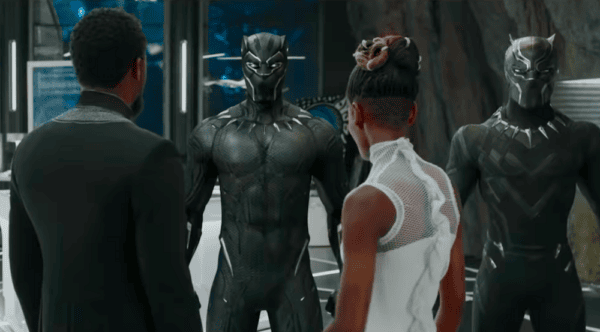
[Image above] Although the vibranium that composes Black Panther’s suit is a fictitious material, it can serve as a hook to interest students in chemistry. Credit: Marvel Entertainment, YouTube
I don’t know about you, but there is one thing at the top of my agenda for this weekend—“Avengers: Endgame” has finally arrived!
It has been over 10 years since “Iron Man” first debuted, and since then, 20 more movies have been released to round out the Marvel Cinematic Universe. All these movies have led up to one thing—the final battle against Thanos, a battle which will play out in the new movie that hits theaters in the United States today.
In light of the fact that “Endgame” opens today, we at CTT decided it was the perfect time to have some fun by taking a look at how one very important Marvel material can help students learn about real materials and chemistry.
Vibranium, the rarest (fictitious) metal on earth
Last year in March, just a few weeks after the premier of “Black Panther,” we published an article on vibranium, a fictional material that plays a central role in the Marvel Universe. Vibranium is said to have some amazing properties, such as being able to deflect kinetic energy and absorb vibrations—no wonder Black Panther’s suit and Captain America’s shield is made of the stuff!
Fans and scientists have debated where vibranium would be placed on the periodic table if it was a real element, and for one scientist, that question served as inspiration to design a student activity.
When Sibrina Collins, an inorganic chemist and STEM administrator in The Marburger STEM Center at Lawrence Technological University, saw “Black Panther” in 2018, she saw an opportunity to interest students in the periodic table.
“I said to myself, ‘If vibranium really existed, where would it be in the periodic table?’ I could not stop thinking about the question, so I began to write down some ideas,” Collins explains in an email.
Those ideas eventually resulted in the publication of two papers, each detailing how vibranium can be used to teach students about elements and transition metal chemistry.
Black Panther, the periodic table, and transition metal chemistry
In 2018, Collins and her colleague LaVetta Appleby published their first vibranium-based paper, which described an activity to encourage students to think critically about the arrangement of elements on the periodic table. The activity involved instructors asking students to place vibranium on the periodic table, and then having the students explain their choices.
While Collins says there is no real right or wrong answer—vibranium is fictional, after all—there are some places on the periodic table it would be more likely to fit than others.

Where would vibranium belong on the periodic table? Thinking about this question can help students learn what distinguishes each element group from one another. Credit: Glrx, Wikimedia
“Vibranium actually emits energy, which could indicate that it is radioactive like the lanthanides and actinides,” Collins says. “Also, it is said to be able to dissolve all metals and absorb sound, which are very unique properties. Transition metals and the f-block elements have unique properties, thus I think it should be placed in the transition metal (d-block) or f-block.”
As thought-provoking as this activity was, Collins and her colleagues felt it could be even more informative. So, in March of this year, they published another paper extending their original activity—with a hands-on exercise letting students prepare their own “vibranium” solutions!
The extended activity starts similarly to the original one, with a discussion of where vibranium may fit on the periodic table. Then, students are provided with worksheets instructing them how to mix various copper- and cobalt-based solutions, resulting in a solution with a vibrant violet-purple color (the same color as a fictitious vibranium solution). Afterwards, instructors talk to students about why the color change occurred (water molecules coordinated to cobalt were replaced by bipyridine and glycine molecules).
The importance of diversity in STEM education
As mentioned earlier, both Black Panther’s suit and Captain America’s shield are made of vibranium. So why did Collins and her colleagues focus on presenting vibranium based on the Black Panther context when developing their activity? The recent release and popularity of “Black Panther” was only part of the reason—diversity also played a huge role.
“The character of Shuri, who leads the STEM advances for Wakanda, provides a shining example of what is possible in STEM,” Collins says. “Young people need to see images of people that look like them doing STEM. I personally believe that everybody should be a chemist, but as educators we need to let young people know that a career in STEM is possible.”
Collins was similarly inspired in 2016, when the movie “Hidden Figures” hit theaters. In 2017, she and her colleagues published a summary of a two-week middle school summer camp they developed based on the film.

When young people see someone like themselves onscreen, it can give them confidence to pursue jobs in that career field as well. (Left) Katherine Johnson in “Hidden Figures” (Credit: 20th Century Fox, YouTube); (right) Shuri in “Black Panther” (Credit: Avengers MV, YouTube)
With the release of “Avengers: Endgame,” we will see the last of the cameos recorded by Stan Lee before he passed away in November. What will future Marvel movies look like now that he is gone? One thing is for sure—his “science” will continue to live on, providing scientists and educators creative ways to entice the next generation of future scientists!
Collins and Appleby’s first Black Panther paper, published in Journal of Chemical Education, is “Black Panther, vibranium, and the periodic table” (DOI: 10.1021/acs.jchemed.8b00206).
Collins and colleagues’ second Black Panther paper, published in The Chemical Educator, is “What can Black Panther teach us about transition metal chemistry?” (ISSN: 1430-4171).
Author
Lisa McDonald
CTT Categories
- Education


